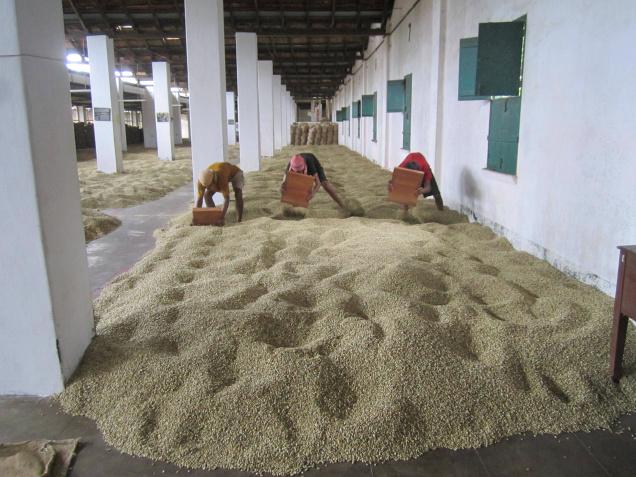(RENUKA PHADNIS | Hindu)
‘Monsooned Malabar’ has a loyal following in the U.S. & Europe
The coffee industry everywhere is seasonal and shut during the monsoons but a handful of units in Mangalore get busy now. The onset of the monsoon means it is time for processing the celebrated ‘Monsooned Malabar,’ the coffee sought the world over for its unique chocolatey and musty taste, said to originate from the exposure of the beans to the moisture-laden monsoon winds blowing in from the Arabian Sea.
M. Suman Ram, senior manager, Aspinwall and Co. Ltd., a company which claims is the pioneer of the ‘Monsooned Malabar,’, is processing 3,500 tonnes of coffee this year. He told The Hindu that the coffee is from “upcountry, Chikmagalur, Hassan and Kodagu. For Monsooned Malabar, it is Arabica only.”
At its factory, the beans are scattered, left open to the elements (“monsooned”), packed and exported to countries where buyers roast it for use in blends. Some buyers of Mangalore’s ‘Monsooned Malabar’ are Nestle Nespresso in Belgium, Benecke Coffee in Germany, Grecof and Blaser Trading, both in Switzerland, besides one buyer from India.
The coffee is scattered on the floor to absorb the moisture from the humid air. Once a day, for the next week to 10 days, the coffee beans are turned over with wooden rakes. Next, the scattered coffee is kept in “wind rows”, which are jute sacks filled with coffee stored in lines with a passage for the monsoon wind to blow through. During that time, the next batch of coffee is put on the floor. Each batch goes through this process three times.
When the factory opens for the regular workers after the monsoons, the monsooned coffee is sent to the machine room where it is “polished” (the outer skin is removed) and graded. After the grading, it is manually sorted to remove defects, bulked, fumigated, packed and exported, mainly to the U.S., Europe and China. The company exports 3,000 tonnes of which 80 per cent goes to Germany and Italy, 10 per cent to the U.S. and the rest to other countries.
Tracing its origin, he related how coffee beans would go from Mangalore to Europe in wooden boats without a motor. Through the six to eight-month voyage on the high seas, the coffee beans absorbed the moisture, bloated and turned brown from green on reaching the destination. When the motorised liners came, the journey took 20 days, cutting short the time of exposure of the coffee beans to the sea winds. People asked for the old coffee, which they thought tasted better. That is how the weathering process came to be simulated on land, though with little success. Some tried it with artificial showers, which spoiled the coffee. “They tried in Hassan, it didn’t work,” he said.
The company has stiff competition from others who have taken up godowns in Mangalore to make the feted coffee bean. “There are a lot of parties (five to six) now,” he said. Another challenge is keeping the beans free of weevils.

